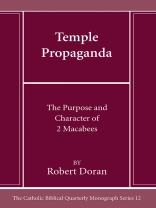This work first addresses the unity of 2 Maccabees, arguing that the epitome is a unified piece, separate from the prefixed letters. The author then explores the syntax and style of the epitome, noting rhetorical features and arguing that the work uses a nicety of syntax associated with classical, literary writers. The analysis of the narrative reveals a three-fold structure: (a) 2 Macc 3–the attack of Heliodorus; (b) 2 Macc 4:1–10:9–the profanation of the temple and its purification; (c) 2 Macc 10:10–15:36–the defense of the temple. Besides the theme of the defense of the temple, this analysis also revealed the theme defending the Jews against attacks that they are anti-social. Finally, the author explores the epitome in relation to Hellenistic historiography. He argues against the notion that the epitome of 2 Maccabees belongs to the genre of ‘pathetic history, ‘ and instead demonstrates that the work belongs to the sub-genre of the defense of a temple by its god.
เกี่ยวกับผู้แต่ง
Robert Doran is professor of religion at Amherst College.







![ปกของ Brian Schrag & Julisa Rowe: Community Arts for God's Purposes [Chinese] 貼近神心意的社群藝術 ปกของ Brian Schrag & Julisa Rowe: Community Arts for God's Purposes [Chinese] 貼近神心意的社群藝術](https://static.worldofdigitals.com/thumb_webp/740/9781645083740.webp)




